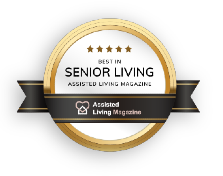|
“How much does assisted living cost?” This is a question we get a lot. The second question I reliably get after is, “why is this information so hard to find online?” The truth is that because the costs vary so much depending on the care needed by each resident, it can be difficult for many to provide an estimate without a doctor or nurse assessing the potential resident. I'll do my best to explain the factors that influence pricing variability in assisted living today (in 2021) so that you can make the best choice for you or your loved one. There are two types of costs to be aware of that influences an assisted living’s pricing. First, there are the fixed costs. This is the mortgage for the facility and the amenities of the facility. This fixed cost varies greatly facility by facility and depends on size of building and staff, as well as other amenities offered to all residents, such as a hair salon, walking paths, swimming pools, etc. Second, there are costs that are specific to each resident that can vary widely. These are called variable costs. The costs associated with food, staffing, medical care, and assistance with the activities of daily life change depending on the needs of the resident. For example, a resident who is mainly independent, but needs help cooking meals has lower costs than a resident who needs assistance getting out of bed, dressing, showering, and eating because staff are devoting more hours to the second resident than the first. Additionally, a resident’s needs typically increase as they age, which results in the corresponding increasing expenses. According to the 2020 Genworth Financial Cost of Care Survey (https://www.genworth.com/aging-and-you/finances/cost-of-care.html) the average cost of assisted living across the country is $4,300 per month. In Wichita Kansas, where we are located, the average is higher than the national average at $5,168 per month. In an effort to deal with the variable nature of caring for a resident there have been a few different pricing models that the industry has adopted:
The inclusive fee is just what it sounds like, there is one price and that covers everything from care, to the room, to food, to activities. The benefits to this pricing are straight forward, no surprise charges every month to worry about and it is much easier to fit into a fixed income situation. The downside to this type of pricing is that because of the large variability in cost associated with each resident, the price has to be sufficiently high to cover the additional expenses of higher-need residents and that leads to the lower care (and thereby lower cost) residents subsidizing the care of the residents that need more help. The Al-a-cart model is characterized by a base rate that covers the rent for the room and then everything else is charged on per-usage basis. The benefit of this model is that there is more transparency on the services required and rendered and you are only paying for the services you need. For example, if your mom wants to prepare her own meals, she wouldn’t be paying extra for the food the facility is preparing and she is not eating. The downside of the al-a-cart pricing is that it is guaranteed to be different every month and thereby it is hard to budget for. Additionally, it can be frustrating for families and residents to keep track of all of the items. This becomes especially challenging if the resident is experiencing memory problems and is no longer able to verify if a billed service was performed or not. Most facilities, including ours, have adopted a hybrid of two approaches. There is a base rate that varies by room choice (studio, private room, double rooms) and “care tiers” related to how much help a resident needs with the activities of daily life. The base price includes many services that are variable in nature, but generally required or requested by the majority of the population. These services include things like meals, laundry services, TV, internet etc. The al-a-cart items of the hybrid model are usually care-related items that may require specialized assistance. For example, facilities may charge a per-occurrence fee on things like insulin administration, specialized nursing care, and care products (i.e., adult diapers and wipes), room service (bringing food to and from a residents room), using the community transportation for doctors visits etc. Make sure when you tour or call a facility that you understand what items are included in the base price and if there are any additional items that are charged on a per-occurrence case. The “deposit” type of model is rarely used in the industry, but it generally involves a large deposit to “buy-in” to the community. These communities typically include a 55+ independent living community, an assisted living community, and a nursing home (in order of care level required). A prospective resident will move into the 55+ independent living community with a large deposit (typically around $100,000+). The resident takes care of all of their expenses independently while they are in the 55+ community. The deposit grantees them a spot and care when it is time to move into the assisted living facility and eventually, the nursing home. The deposit also covers the cost of their room, board and care while they are in the facility. The advantage of this model are that there are no monthly bills other than any per-occurrence fees (if they charge them). Additionally, if a resident’s lifetime costs outpace their deposit, their place in the facility and care is typically guaranteed for the duration of their life. Generally, if a resident passes away prior to exhausting the deposit, a portion of the deposit is returned to their estate. The downside of this model is that there is not very clear transparency on why the returned deposit amount is what it is. Additionally, the large nature of the deposit may be prohibitive for those on a fixed income. If you are interested in this type of model, make sure that you understand how the deposit is handled and returned and the scenarios (if any) where a residents place and care in the facility may not be guaranteed (for example if the resident become combative etc.). Keep these additional things in mind, also, as you contemplate costs associated with a care facility transition. First, you will want to understand how the facility evaluates what level of care you or your loved one needs and how the pricing changes accordingly. Many facilities charge a one-time “community fee” when a resident moves in. This helps the facility cover the cost of preparing and repairing the rooms for the new resident (painting, replacing carpet, and deep cleaning of the room). This fee generally ranges from $1,000-$4,000. Most facilities have a “cost of living adjustment” that happens at the beginning of each year. This usually results in an increase of 1-4% per year. Finally, much like a traditional rental agreement, most facilities require a 30 day notice for moving out. I hope this information has been helpful to you! Remember, everybody is different and the different pricing models available provide flexibility when making a choice for you or your loved one. Please feel free to reach out to us anytime if you have questions at [email protected]. We realize we may not be a fit for your assisted living needs, but we would love to be helpful in any way that we can. Disclaimer: This video and article are for educational purposes only. It is not intended to provide any legal, medical, financial or other professional advice. As with all of our educational content we encourage you to seek out competent advice from licensed professional. While we make our best effort to provide correct and up-to-date information we cannot guarantee the accuracy of the information provided.
0 Comments
|
Archives
May 2024
Categories |


 RSS Feed
RSS Feed

